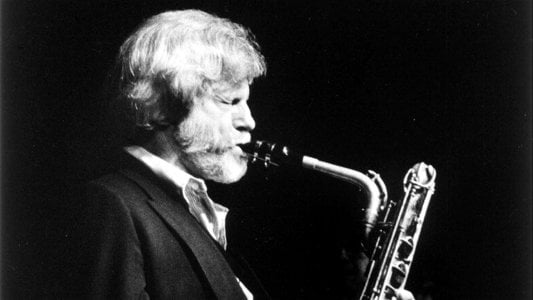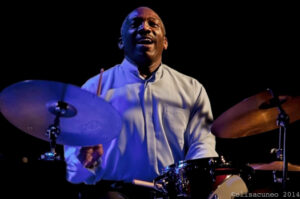06.04. – Happy Birthday !!! Gerry Mulligan grew up in Philadelphia and first learned piano, which he played occasionally. While in his teens, he wrote arrangements for Johnny Warrington’s radio band (1944) and played reed instruments professionally.
After moving to New York in 1946, he joined Gene Krupa’s big band as staff arranger, attracting attention with his Disc Jockey Jump (1947). He then became involved with the nascent cool-jazz movement in New York, taking part in the performances (1948) and recording sessions (1949-50) of Miles Davis’ nonet and contributing scores to the big bands of Elliot Lawrence and Claude Thornhill. By this time, he was specializing in baritone saxophone and playing in groups with Kai Winding and others. He also wrote scores for Stan Kenton’s band and recorded with his own tentet (1951), which was modeled on Davis’s ensemble.
In 1952, Mulligan, then based in Los Angeles, formed his first “piano-less” quartet, with Chet Baker on trumpet. The group was instantaneously successful and brought Baker and Mulligan international acclaim. Mulligan led a new tentet and various versions of the quartet throughout the mid-1950s. He made a sensational appearance at the Salle Pleyel in Paris in 1954 and began dominating jazz opinion polls for his instrument. In 1960, he organized his own 13-piece concert jazz band with which he toured Europe in that year and Japan in 1964. After it disbanded, he became an active sideman, working often with Dave Brubeck (1968-72) and as a freelance arranger for other jazz groups. He formed a new 14-piece big band, the Age of Steam, in 1972, and was artist-in-residence at Miami University in 1974.
From 1974 to 1977, Mulligan led a sextet that included Dave Samuels, and during this period he worked regularly in New York and Italy. Around the same time he began playing soprano saxophone. He formed a 14-piece band in 1978 and toured with it into the following year. During the early 1980s, he made recordings as a leader in New York that involved experiments with a 20-piece big band (1980) and electronic instruments (1982-3), but in 1986 he returned to a more familiar format as the leader of a quintet with Scott Hamilton and Grady Tate.
Mulligan is among the most versatile figures in modern jazz. Although slow to develop as an instrumentalist, he has long been recognized as the most important baritone saxophonist in jazz since Harry Carney. Besides the cool idiom that he helped to create, he is equally at home in a big-band, bop, or even Dixieland context (playing clarinet in the latter), and his excellent recordings with musicians as varied as Johnny Hodges and Thelonious Monk show an unusual musical adaptability. Initially, however, Mulligan made his reputation as an arranger of band scores with intricate inner parts, careful balancing of timbres, low dynamics, and light swing, all of which features are present in his settings of Jeru, Godchild, and Venus de Milo for Davis’ nonet. Later, he abstracted these qualities in his piano-less groups, where the low volume and absence of chordal underpinnings freed the wind players to improvise in delicate two-part counterpoint. Some of Mulligan’s best playing may be heard in his recordings with Chet Baker, Bob Brookmeyer, and most notably Paul Desmond, with whom he shares an unusual talent for improvised countermelody.
https://www.youtube.com/watch?v=AMQD3Bv5ZG4







More Stories
CD review: George Benson – Dreams Do Come True: When George Benson Meets Robert Farnon – 2024: Video, CD cover
The band was tight as ever. The Warren Haynes Band cuts loose: Video, Photos
Interview with Alvin Queen: Feeling Good – I heard these tunes played by … Video, new CD cover, Photos